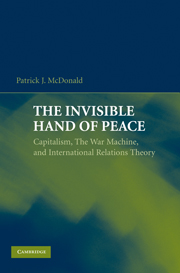Book contents
- Frontmatter
- Contents
- List of Tables
- Acknowledgments
- 1 American Grand Strategy and the Liberal Peace
- 2 Liberal International Relations Theory on War
- 3 Releasing the Invisible Hand
- 4 Liberal Economic Institutions and Peace in the Twentieth Century
- 5 Free Trade and Peace in the First Era of Globalization
- 6 From Rivalry to Friendship
- 7 The Achilles' Heel of Liberal International Relations Theory?
- 8 Peace Across the Taiwan Strait?
- 9 The Invisible Hand or the Ballot Box?
- 10 Capitalism and America's Peaceful Market Power
- References
- Index
3 - Releasing the Invisible Hand
Published online by Cambridge University Press: 05 June 2012
- Frontmatter
- Contents
- List of Tables
- Acknowledgments
- 1 American Grand Strategy and the Liberal Peace
- 2 Liberal International Relations Theory on War
- 3 Releasing the Invisible Hand
- 4 Liberal Economic Institutions and Peace in the Twentieth Century
- 5 Free Trade and Peace in the First Era of Globalization
- 6 From Rivalry to Friendship
- 7 The Achilles' Heel of Liberal International Relations Theory?
- 8 Peace Across the Taiwan Strait?
- 9 The Invisible Hand or the Ballot Box?
- 10 Capitalism and America's Peaceful Market Power
- References
- Index
Summary
Multiple socialist writers – including Lenin, Hilferding, and Hobson – have linked the ills of capitalism, particularly the concentration of wealth, within countries to relationships of rivalry and military conflict among states in the international system. The same pressures within capitalism that encouraged ruthless competition and the acquisitiveness of wealth by private individuals simultaneously encouraged territorial expansion by governments. By pressing down wages at home, capitalists undermined the purchasing power of the local labor class and contributed to falling profits. These economic losses at home could be offset by securing cheap sources of raw materials and new outlets for manufactured products in the developed world. Once the supply of these new market outlets dried up in the periphery, the developed countries turned against each other in a zero-sum competition to protect existing markets and deprive competing powers of the same imperialist relief. Thus European great powers and the United States first carved up Africa, Asia, the near East, and South America into colonial outlets. The ensuing conflict in these rivalries eventually gave way to both World War I and World War II. Contemporary descendants of such claims (e.g., Williams 1959; LaFeber 1998[1963]; McCormick 1995[1989]; Layne 2006) suggest that the outbreak of peace in Europe after 1945 failed to bring a reprieve from these expansionist tendencies. The United States and Soviet Union continued to vie for political and economic influence in these regions of the world.
- Type
- Chapter
- Information
- The Invisible Hand of PeaceCapitalism, the War Machine, and International Relations Theory, pp. 50 - 76Publisher: Cambridge University PressPrint publication year: 2009



